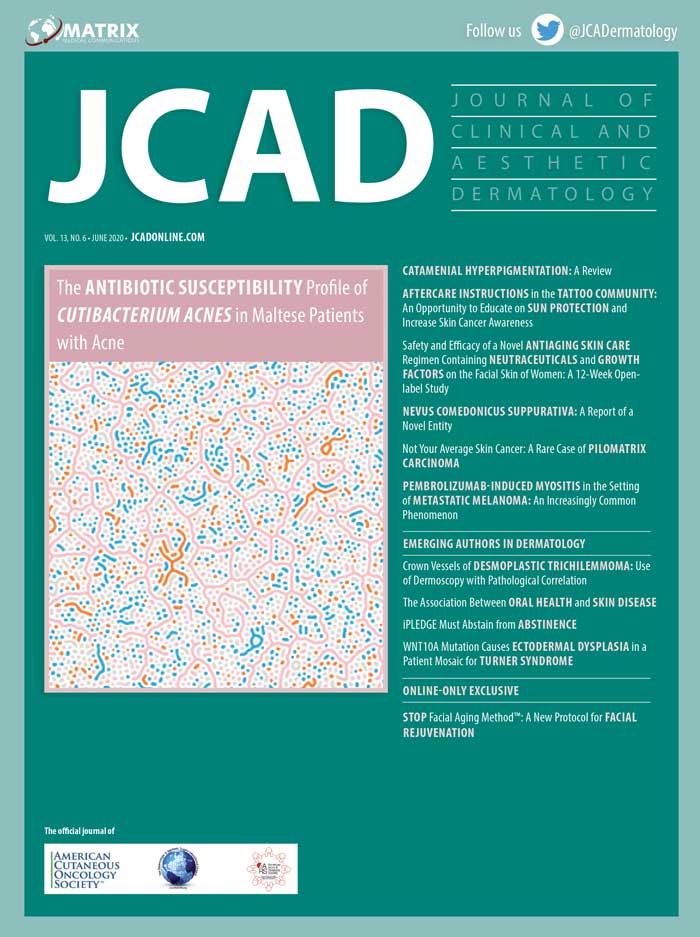Vol. 13, No. 6 • June 2020
Dear Colleagues:
 Welcome to the June 2020 issue of The Journal of Clinical and Aesthetic Dermatology. We begin this issue with original research from Mercieca et al, titled, “The Antibiotic Susceptibility Profile of Cutibacterium Acnes in Maltese Patients with Acne.” Here, the authors investigated the susceptibility profile of C. acnes isolates from patients with acne in Malta to antibiotics commonly used to treat the condition, then compared their data with global data. These antibiotics included azithromycin, clindamycin, doxycycline, minocycline, tetracycline, and trimethoprim/sulfamethoxazole. The highest resistance was observed to azithromycin, followed by clindamycin. Resistance to doxycycline and tetracycline was only found in two percent of the isolates and there was no resistance to trimethoprim/sulfamethoxazole or minocycline.
Welcome to the June 2020 issue of The Journal of Clinical and Aesthetic Dermatology. We begin this issue with original research from Mercieca et al, titled, “The Antibiotic Susceptibility Profile of Cutibacterium Acnes in Maltese Patients with Acne.” Here, the authors investigated the susceptibility profile of C. acnes isolates from patients with acne in Malta to antibiotics commonly used to treat the condition, then compared their data with global data. These antibiotics included azithromycin, clindamycin, doxycycline, minocycline, tetracycline, and trimethoprim/sulfamethoxazole. The highest resistance was observed to azithromycin, followed by clindamycin. Resistance to doxycycline and tetracycline was only found in two percent of the isolates and there was no resistance to trimethoprim/sulfamethoxazole or minocycline.
Following this, we present a review from Mobasher et al in which the authors examined the literature on catamenial skin hyperpigmentation and menses-induced exacerbations of skin pigmentation disorders. Using PubMed/MEDLINE and the Cochrane Skin database, the authors assessed the relevant literature on skin diseases related to nonpathological menstruation.
Next, Gonzalez et al provide a commentary addressing sun protection among the tattoo community. According to the authors, most tattoo artists do not report having sufficient knowledge pertaining to comprehensive sun safety recommendations. The authors discusses how tattoo shops can serve as a viable environment for intervention to promote accessible full-body skin cancer prevention recommendations.
Following this, we present original research by G. Sadowski and J. Sadowski, in which the authors present results from safety and efficacy evaluations of an antiaging skin care regimen containing neutraceuticals and growth factors. In their 12-week, open-label study, the authors assessed effects of the skin care regimen on hydration, firmness, elasticity, wrinkling, and pore size of facial skin in 32 women.
After, we present a case report of a six-year-old female child with congenital linear nevus comedonicus complicated by recurrent HS-like lesions. After reviewing the literature, Sharma et al proposed a novel term, nevus comedonicus suppurativa, to describe this clinical entity.
Next, White et al describe the case of a 62-year old male patient with a growing red mass on his forehead who was treated with surgical intervention and radiology. The authors believe this neoplasm, an aberrant proliferation of matrical cells found in developing hair as a result of pilomatrix carcinoma, is often overlooked by clinicians and should be considered when treating patients in order to prevent recurrence and metastasis of the skin disease.
As part of our “Emerging Authors in Dermatology” series, we present four articles from rising authors in the field of dermatology. First, Colon et al report the case of an 81-year-old male patient with desmoplastic trichilemmoma, a rare histological variant of a benign tumor of the pilosebaceous hair follicle, found on the left zygoma. Following this, Mackliss et al evaluate the link between skin conditions and oral health metrics by reviewing previously published studies via the PubMed search engine to determine how oral diseases can impact the development of several conditions, such as aphthous stomatitis, atopic dermatitis, lichen planus, pemphigus, pemphigoid, and psoriasis. Next, in a commentary from Lowery et al, the authors dispute the efficacy of abstinence for preventing pregnancy in patients receiving treatment with isotretinoin. The authors argue for the use of data-proven contraception in all patients of reproductive potential receiving isotretinoin to reduce the number of pregnancies among these patients, enhance patient privacy protection, and standardize patient care. After, Pasadyn et al present the case of a five-year-old patient who is mosaic for Turner syndrome with anhidrosis, conical-shaped teeth, a slowed rate of hair growth, and a pathogenic heterozygous variant in WNT10A.
Finally, don’t miss our online-only exclusive article, in which the author discussed the Sebban Technique One-point Facial Aging Method™ for hyaluronic acid fillers, which aims to offer predictive results using a single point of entry by combining two complementary techniques: Deep One-point, which restructures facial architecture by targeting the deep plane of the skin, and Superficial One-point, which is more superficial, targeting hypodermic plans in order to add volume and optimal tissue hydration.
We hope you enjoy this issue of JCAD. As always, we welcome your feedback and submissions.
With regards,
James Q. Del Rosso, DO, FAOCD—Editor-in-Chief, Clinical Dermatology
Wm. Philip Werschler, MD, FAAD, FAACS—Editor-in-Chief, Aesthetic Dermatology
Seemal R. Desai, MD, FAAD— Associate Editor

